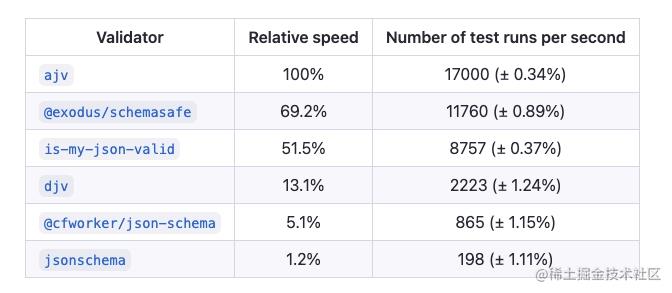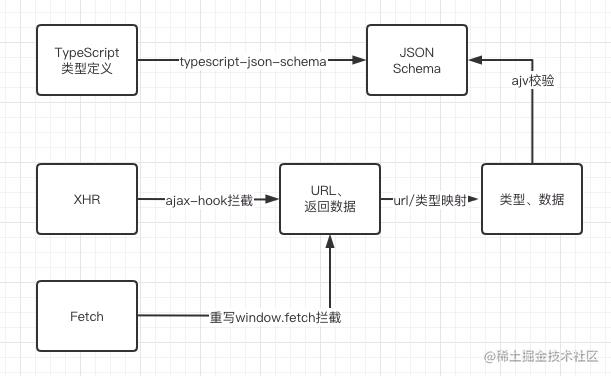如何优雅地校验后端接口数据,不做前端背锅侠
Posted 我不吃饼干呀
tags:
篇首语:本文由小常识网(cha138.com)小编为大家整理,主要介绍了如何优雅地校验后端接口数据,不做前端背锅侠相关的知识,希望对你有一定的参考价值。
背景
最近新接手了一批项目,还没来得及接新需求,一大堆bug就接踵而至,仔细一看,应该返回数组的字段返回了 null,或者没有返回,甚至返回了字符串 "null"???
这我能忍?我立刻截图发到群里,用红框加大加粗重点标出。后端同学也积极响应,答应改正。

第二天,同样的事情又在其他的项目上演,我只是一个小前端,为什么什么错都找我啊!!
日子不能再这样下去,于是我决定写一个工具来解决遇到 bug 永远在找前端的困境。
TypeScript 运行时校验
如何对接口数据进行校验呢,因为我们的项目是 React+TypeScript 写的,所以第一时间就想到了使用 TypeScript 进行数据校验。但是众所周知,TypeScript 用于编译时校验,有没有办法作用到运行时呢?
我还真找到了一些运行时类型校验的库:typescript-needs-types,大部分需要使用指定格式编写代码,相当于对项目进行重构,拿其中 star 最多的 zod 举例,代码如下。
import z from "zod";
const User = z.object(
username: z.string(),
);
User.parse( username: "Ludwig" );
// extract the inferred type
type User = z.infer<typeof User>;
// username: string
我宁可查 bug 也不可能重构手里一大堆项目啊。此种方案 ❎。
此时看到了 typescript-json-schema 可以把 TypeScript 定义转为 JSON Schema ,然后再使用 JSON Schema 对数据进行校验就可以啦。这种方案比较灵活,且对代码入侵性较小。
搭建一个项目测试一下!
使用 npx create-react-app my-app --template typescript 快速创建一个 React+TS 项目。
首先安装依赖 npm install typescript-json-schema
创建类型文件 src/types/user.ts
export interface IUserInfo
staffId: number
name: string
email: string
然后创建 src/types/index.ts 文件并引入刚才的类型。
import IUserInfo from \'./user\';
interface ILabel
id: number;
name: string;
color: string;
remark?: string;
type ILabelArray = ILabel[];
type IUserInfoAlias = IUserInfo;
接下来在 package.json 添加脚本
"scripts":
// ...
"json": "typescript-json-schema src/types/index.ts \'*\' -o src/types/index.json --id=api --required --strictNullChecks"
然后运行 npm run json 可以看到新建了一个 src/types/index.json 文件(此步在已有项目中可能会报错报错,可以尝试在 json 命令中添加 --ignoreErrors 参数),打开文件可以看到已经成功转成了 JSON Schema 格式。
"$id": "api",
"$schema": "http://json-schema.org/draft-07/schema#",
"definitions":
"ILabel":
"properties":
"color":
"type": "string"
,
"id":
"type": "number"
,
"name":
"type": "string"
,
"remark":
"type": "string"
,
"required": [
"color",
"id",
"name"
],
"type": "object"
,
"ILabelArray":
"items":
"$ref": "api#/definitions/ILabel"
,
"type": "array"
,
"IUserInfoAlias":
"properties":
"email":
"type": "string"
,
"name":
"type": "string"
,
"staffId":
"type": "number"
,
"required": [
"email",
"name",
"staffId"
],
"type": "object"
使用 JSON Schema 校验数据
至于如何使用JSON Schema 校验数据,我找到了现成的库 ajv,至于为什么选择 ajv,主要是因为它说它很快,详见:https://github.com/ebdrup/json-schema-benchmark/blob/master/README.md#performance

接下来尝试一下。我找到了中文版文档,有兴趣的可以去看下 http://www.febeacon.com/ajv-docs-zh-cn/。
先安装依赖 npm install ajv,然后创建文件 src/validate.ts
import Ajv from \'ajv\';
import schema from \'./types/index.json\';
const ajv = new Ajv( schemas: [schema] );
export function validateDataByType(type: string, data: unknown)
console.log(`开始校验,类型:$type, 数据:`, data);
var validate = ajv.getSchema(`api#/definitions/$type`);
if (validate)
const valid = validate(data);
if (!valid)
console.log(\'校验失败\', validate.errors);
else
console.log(\'校验成功\');
接下来在 src/index.tsx 添加下面代码来测试一下。
validateDataByType(\'IUserInfoAlias\',
email: \'idonteatcookie@gmail.com\',
name: \'idonteatcookie\',
staffId: 12306
)
validateDataByType(\'IUserInfoAlias\',
email: \'idonteatcookie@gmail.com\',
staffId: 12306
)
validateDataByType(\'IUserInfoAlias\',
email: \'idonteatcookie@gmail.com\',
name: \'idonteatcookie\',
staffId: \'12306\'
)
可以在控制台看到成功打印如下信息:

拦截请求
因为项目中发送请求都是调用统一封装的函数,所以我首先想到的是在函数中增加一层校验逻辑。但是这样的话就与项目代码耦合严重,换一个项目又要再写一份。我真的有好多项目QAQ。
那干脆拦截所有请求统一处理好了。
很容易的找到了拦截所有 XMLHttpRequest 请求的库 ajax-hook,可以非常简单地对请求做处理。
首先安装依赖 npm install ajax-hook,然后创建 src/interceptTool.ts:
import proxy from \'ajax-hook\';
export function intercept()
// 获取 XMLHttpRequest 发送的请求
proxy(
onResponse: (response: any, handler: any) =>
console.log(\'xhr\', response.response)
handler.next(response);
,
);
这样就拦截了所有的 XMLHttpRequest 发送的请求,但是我突然想到我们的项目,好像使用 fetch 发送的请求来着???
好叭,那就再拦截一遍 fetch 发送的请求。
export function intercept()
// ...
const fetch: originalFetch = window;
// 获取 fetch 发送的请求
window.fetch = async (...args) =>
const response = await originalFetch(...args);
response.clone().json().then((data: result: any ) =>
console.log(\'window.fetch\', args, data);
return data;
);
return response;
;
为了证明拦截成功,使用 json-server 搭建一个本地 mock 服务器。首先安装 npm install json-server,然后在根目录创建文件 db.json:
"user": "staffId": 1, "name": "cookie1", "email": "cookie@cookie.com" ,
"labels": [
"id": 1,
"name": "ck",
"color": "red",
"remark": "blabla"
,
"id": 2,
"color": "green"
]
再在 package.json 添加脚本
"scripts":
"serve": "json-server --watch db.json -p 8000"
,
现在执行 npm run serve 就可以启动服务器了。在 src/index.tsx 增加调用接口的代码,并引入 src/interceptTool.ts。
import intercept from \'./interceptTool\';
// ... other code
intercept();
fetch(\'http://localhost:8000/user\');
const xhr = new XMLHttpRequest();
xhr.open(\'GET\', \'http://localhost:8000/labels\');
xhr.send();

可以看到两种请求都拦截成功了。
校验接口返回数据
胜利在望,只差最后一步,校验返回数据。我们校验数据需要提供两个关键信息,数据本身和对应的类型名,为了将两者对应起来,需要再创建一个映射文件,把 url 和类型名对应起来。
创建文件 src/urlMapType.ts 然后添加内容
export const urlMapType =
\'http://localhost:8000/user\': \'IUserInfoAlias\',
\'http://localhost:8000/labels\': \'ILabelArray\',
我们在 src/validate.ts 新增函数 validateDataByUrl
import urlMapType from \'./urlMapType\';
// ...
export function validateDataByUrl(url: string, data: unknown)
const type = urlMapType[url as keyof typeof urlMapType];
if (!type)
// 没有定义对应格式不进行校验
return;
console.log(`==== 开始校验 === url $url`);
validateDataByType(type, data);
然后在 src/interceptTool.ts 文件中引用
import proxy from \'ajax-hook\';
import validateDataByUrl from \'./validate\';
export function intercept()
// 获取 XMLHttpRequest 发送的请求
proxy(
onResponse: (response, handler: any) =>
validateDataByUrl(response.config.url, JSON.parse(response.response));
handler.next(response);
,
);
const fetch: originalFetch = window;
// 获取 fetch 发送的请求
window.fetch = async (...args) =>
const response = await originalFetch(...args);
response.json().then((data: any) =>
validateDataByUrl(args[0] as string, data);
return data;
);
return response;
;
现在可以在控制台看到接口数据校验的接口辣~ ✿✿ヽ(°▽°)ノ✿

总结下流程图

后续规划
目前所做的事情,准确的说不是拦截,只是获取返回数据,然后对比打印校验结果,因为初步目标不涉及数据的处理。
后续会考虑对不合法的数据进行处理,比如应该返回数组但是返回了 null 的情况,如果能自动赋值 [],就可以防止前端页面崩溃的情况了。
参考资料
以上是关于如何优雅地校验后端接口数据,不做前端背锅侠的主要内容,如果未能解决你的问题,请参考以下文章